Welcome to our captivating exploration of shipping containers facts – the unsung heroes of international trade and transportation.
In this article, I will delve into the fascinating world of these metal giants, unearthing their definition, purpose, and unrivaled importance in shaping the global economy.
Defined as large standardized steel boxes, shipping containers are designed to safely store and transport a vast array of goods across continents and oceans.
Whether it’s the latest gadget from Asia or fresh produce from South America, containers play an important role in connecting businesses and consumers worldwide.
The significance of sea containers in international trade cannot be overstated. Without them, the seamless flow of goods between nations would be significantly hampered, leading to very high costs, delayed deliveries, and reduced access to a wide range of products.
These containers act as the life blood of global commerce, which allows for the movement of goods on a massive scale.
Table of Contents
10 Facts About Shipping Containers That you Didn’t Know of
I took time to come up with some of the most common unknown facts about intermodal shipping containers. Take time and go through them below.
Fact 1: Shipping Containers Have Been Moving Cargo for More Than 65 Years
In 1956, the first contemporary container was created. Since then, they have without fail kept and shipped items worldwide.
They can move freight by road, rail, and ship, making them adaptable and practical. Additionally, they are built to haul large, heavy loads with ease.
There are numerous sizes and heights of containers. They are appropriate for many uses and applications across many industries and sectors because of the wide range of sizes and materials available.
You may learn something new and save money by being knowledgeable about your neighborhood’s containers and container sales.
Read More: Build A Container House – How Hard Is It? Expert Advice
Fact 2: Shipping Containers Last a Very Long Time and Are Strong
An interesting fact about containers is that they can endure up to 30 years if given the proper upkeep. Their life span is affected by several elements, such as the nature of the delivered items, the regularity of shipments, and the frequency of repairs.
It is usual for things to break down slowly. Above all, your container can endure for a very long time under the appropriate circumstances.
As a matter of fact, sales of containers have seen a dramatic increase in recent years, and they are expected to continue to rank among the most popular methods of moving goods internationally for many years to come.
To beat and slow down the growth of rust in your container, consider using protective enamel paint such as Rustoleum to stop and reverse rust.
Read More: Shipping Container Roof – Do You Need One?
Fact 3: Most of Them Are Unsinkable
Shipping containers occasionally get lost at sea but usually go only a little far. A full cargo container is likely to spend several days or weeks floating on or just below the water before it finally sinks. The air that was trapped is to blame.
The container will eventually fall to the sea floor as this is released over time. During rescue missions, this might assist safety crews in getting back stolen or lost cargo containers.
With up to 10,000 containers lost to the ocean each year, this can eventually aid in lowering environmental harm and sea pollution.
Read More: Container Home Builders Tampa Florida: Here Are The Best
Fact 4: Shipping Containers Are Trackable
Most commercial containers are given a unique tracking number at the start of their journey. This makes it possible for you to follow its progress around the globe. Additionally, you can regularly be updated on the progress of your package as it travels to its destination.
This is sent to you in real time and is accessible online or on your smart device. As can be seen, with container monitoring, you can stop worrying about where or how your items will arrive.
Read More: How Are Shipping Containers Identified? Expert Explanation
Fact 5: Keith Tantlinger Created the First Shipping Container
Another fact about sea containers is that the container was created by Keith Tantlinger (1919 to 2011). (Chief engineer at Brown Industries).
He made the 30-foot aluminum box in 1949, arguably the first modern storage unit, and could be stacked two high on barges traveling between Seattle and Alaska.
Everyone was amazed by the idea, but regrettably, no one was willing to invest the funds necessary to make it a reality. Marc Levinson’s The Box is the source.
Read More: Can You Put A Shipping Container On Agricultural Land?
Fact 6: Malcolm Mclean Invented the Modern Shipping Container
Since March 1934, Malcolm McLean (1913 to 2001) has been a well respected truck tycoon. McLean requested Tantlinger’s assistance to obtain input on the container concept.
There was significant controversy about what size container might be loaded in a ship’s hold to convey the most goods for the least amount of money.
The well known transportation formula, which started in the early 20th century, McLean made some changes to it in the 1950s. The outdated “break bulk” technique of product handling was replaced by the metal cargo container (intermodal container) that is familiar to us today.
Containerization emerged. McClean realized that keeping the cost of carrying products low required more than simply a metal box—it also needed a completely different approach to handling freight.
The whole shipping system had to adjust, including ports, ships, storage facilities, cranes, trucks, rail roads, and the shippers’ operations. Years ahead of his time, he was. Marc Levinson’s The Box is the source.
Read More: How Do You Prevent Mold In Shipping Containers? Easy
Fact 7: Containers Are Used to Ship Goods Worldwide
The largest shipping port in the world in 2018 was in Shanghai, China. As a matter of fact, 2018 saw the passage of 42 million TEU containers or 20-foot containers. The World Shipping Council is the source.
In 2018, the Port of Felixstowe handled 3.85 million 20-foot equivalent containers. By and large, the bulk of the UK’s containerized traffic and 37% of its container units pass through Felixstowe. Department of Trade in the UK
Remember this important fact about containers. In 2019, the oceans were home to more than 50,000 commerce ships, as the International Chamber of Shipping reported. This is an incredibly high figure.
In 2019, the “OOCL Hong Kong” was noted as the world’s largest cargo ship. The “OOCL Hong Kong,” owned by OOCL, measures 400 meters in length, 58.8 meters wide, and 32.5 meters deep. Indeed, it can hold 21,413 TEU (20 feet equivalent per TEU). In June 2017, the OOCL Hong Kong travelled to Felixstowe.
Read More: 9 Creative Ideas For Shipping Container Home Design And Décor
Fact 8: Another Fact About Shipping Containers — Each Has a Unique Number
One of the most interesting facts about containers is that every single sea container that has ever been made has a unique number.
In particular, a three character code identifying the container’s owner comes first, and the unit number that will follow is normally shown by the letter U.
The actual 7-digit container comes next, the first 6 of which are specific to each container and the final number of which is a check digit determined by a mathematical procedure. Who thought we’d have to tackle math? Heave!
Read More: 15 Best Solar Companies In The Us
Fact 9: What Countries Make Shipping Containers?
One of the major important facts about sea containers is that China makes 97% of all containers made worldwide.
There are many reasons why that is the case, but mainly because China usually has lower labor costs than any other country in the world.
Furthermore, it makes sense to produce these containers in the same region as most other products made across the world.
Additionally, they have huge manufacturing facilities that can handle the machinery with cranes and a considerable amount of outdoor storage space for the constructed containers to be kept before shipping.
Other nations also produce cargo containers, including the USA, Korea, Taiwan, Italy, the UK, France, Poland, and others, but their output pales when compared to China’s.
Read More: The Incredible History Of Shipping Container That Will Amaze You
Fact 10: Container Are Made in Standard and Large Sizes
One of the most important facts about sea containers is that a typical container lengths are 20 feet or 40 feet. Despite being advertised as 20 feet long, the 20-foot units are 19 feet and 10.5 inches long, and the 40-foot units are 40 feet long.
Note that the heights can be either 8 ft 6 in. or 9 ft 6 in., and the normal widths are 8 ft. The Hi cubes are 9 ft 6 in height units.
There are more than 20 million sea containers in use worldwide as of 2012, and five to six million of them are moved by trucks, rail, and ships. They travel together on about 200 million journeys in any given year.
According to estimates, 10,000 containers are lost at sea yearly (including accidents). In short, that amounts to nearly 192 containers each day! Singularity Hub as a source.
Waves can damage and sink lost containers. The ones that don’t drop normally float below the water’s surface, which can seriously harm other sailing ships.
Read More: Here Is What You Need To Know About Shipping Container Pools
History and Evolution of Shipping Containers
A. The Origins of Containerization
I had talked about this earlier in the beginning, but it doesn’t hurt to give more details. And so, in the ancient civilizations, early forms of containerization can be found.
Merchants and traders would use specific vessels to transport their goods, making sure that they were protected during long voyages.
These containers were often made from materials such as wood or clay and were used to transport various products, including food, clothing, and even animals.
However, it wasn’t until the 20th century that standardized sea containers emerged. In the 1950s, Malcolm McLean, an American trucking entrepreneur, changed the shipping industry by introducing the concept of containerization.
By and large, he developed a standardized container that could be easily loaded onto ships, trucks, and trains, simplifying the entire logistics process.
B. Impact of Containerization on International Trade
The introduction of containerization had a great impact on international trade. And so with the use of standardized containers, efficiency improvements and lower cost became major benefits.
Loading and unloading times were significantly reduced, as containers could be easily moved using cranes and other handling equipment. This smooth process led to shorter turn around times for vessels and reduced labor costs.
Furthermore, containerization played a crucial role in the growth of global markets. The ability to transport goods quickly and efficiently across long distances opened up new trade routes and opportunities for businesses.
Products from different regions could be easily moved from place to place and distributed, leading to higher international trade and economic growth.
Read More on Affordable Homes in Adelaide – Here’s How To Go About It
Types and Dimensions of Shipping Containers Currently in the Market
A. Introduction to Different Types
When it comes to sea containers, there are several different types available, each designed to meet specific transport and storage needs. Some of the most common types that you are most likely to bump into include:
- Standard Containers: These are the most commonly used containers, with a length of either 20 feet or 40 feet. They have a standard height of 8 feet 6 inches.
- High Cube Containers: High cube containers are similar to standard ones in length, but they offer extra vertical space with a height of 9 feet 6 inches. This extra height makes them ideal for transporting tall or bulky items.
- Flat Rack Containers: Flat rack containers have collapsible sides, which makes it possible for them to be loaded from the top or sides. They are commonly used to transport heavy machinery and oversized cargo such as boats and yatchs.
- Open-Top Containers: Open-top containers are similar to standard containers, but they lack a solid roof. Instead, they have a tarpaulin that can be removed or a hard roof that can be completely or partially removed.
They are often used for moving goods from place to place that require top loading or loading with a crane. Think of plant or factory machines. The truck moves into the factory floor and a crane that is placed on top then safely lifts the machine or part, and the truck drives away. - Refrigerated Containers: Also known as “reefers,” refrigerated containers come with a cooling system that maintains a specific temperature for transporting perishable goods.
B. Detailed Descriptions and Diagrams for Each Type
Let’s take a closer look at each type of sea container complete with photos so that you can have a mental picture of what we are talking about.
Another point that I should add, shipping containers come in various grades, that is A, B, and C. Grade A is food grade, and close to new as possible. Grade B may have a few dents but is wind and watertight, which grade C is as-is basis. That is it might have a lot of rust, may be leaking, and not suitable to transport goods.
And so, if you are to build a home with one, Grade A is the best, but expensive, hence Grade B will be the best bet.
So while going through the pictures, try and figure out which one is Grade A, B, or C and leave a comment at the end of the article.
Standard Containers
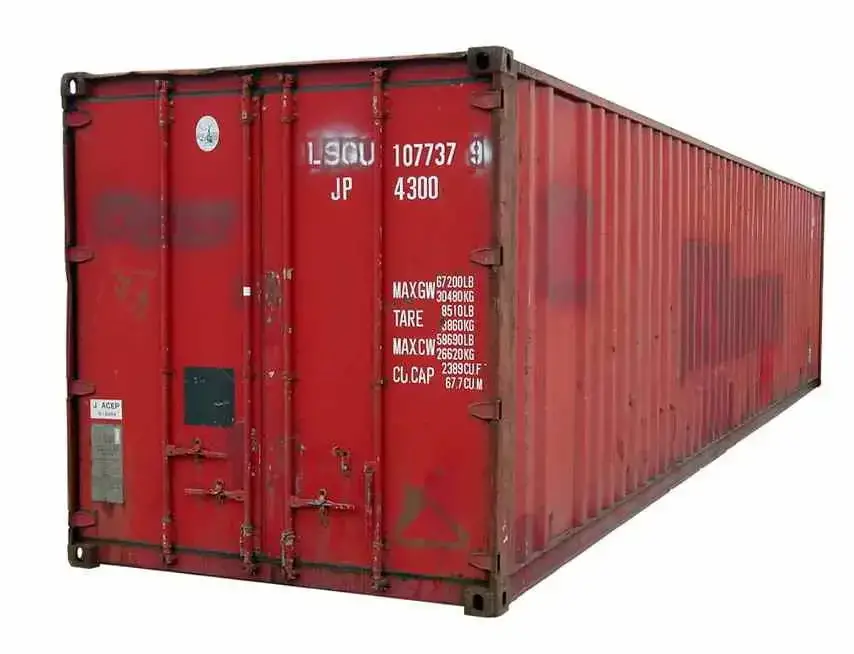
To point out, standard containers are available in two lengths: 20 feet and 40 feet. They are constructed from steel and feature double doors at one end for easy loading and unloading. They are versatile and can carry a wide range of cargo.
Dimensions: The internal size of a standard 20-foot container are roughly 19 feet 4 inches in length, 7 feet 9 inches in width, and 7 feet 10 inches in height.
The internal sizes of a standard 40-foot container are approximately 39 feet 6 inches in length, 7 feet 9 inches in width, and 7 feet 10 inches in height.
High Cube Containers
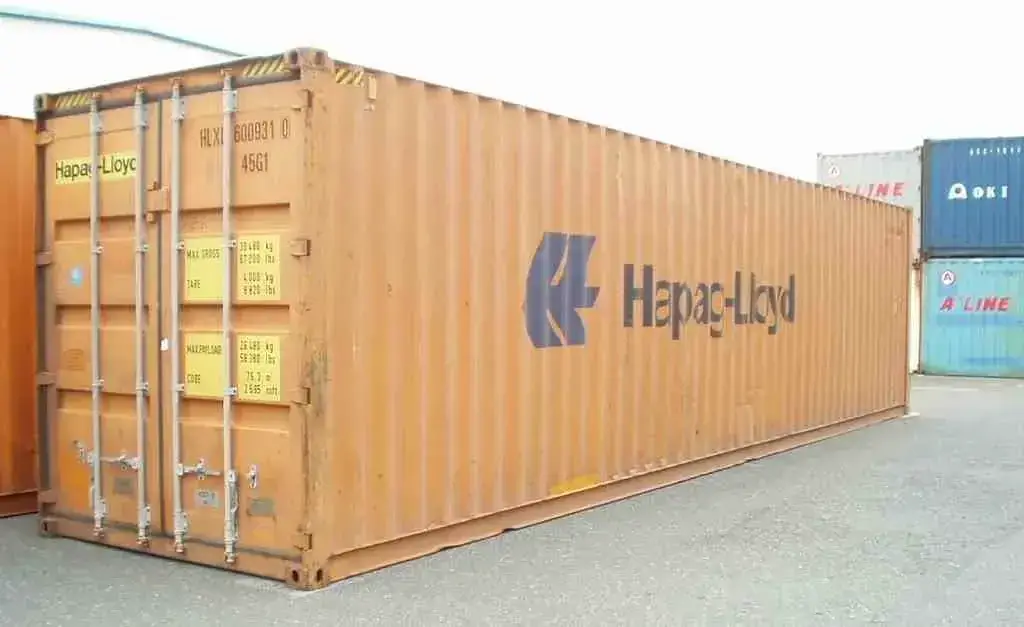
High cube containers have the same lengths as standard containers (20 feet or 40 feet), but provide extra vertical space. This extra height is very important for cargo that exceeds the standard height limitations.
It is also important to add that this type is a favorite for most home owners. This is because of the extra head room which in turn might allow you to walk freely in your home, and add among other things, ceiling fans, extra lights, etc.
Dimensions: The internal sizes of a high cube 20-foot container are roughly 19 feet 4 inches in length, 7 feet 9 inches in width, and 8 feet 10 inches in height.
Finally, the internal dimensions of a high cube 40-foot container are roughly 39 feet 6 inches in length, 7 feet 9 inches in width, and 8 feet 10 inches in height.
Read More on Can I Screw Into A Shipping Container? Simple Explanation
Flat Rack Containers
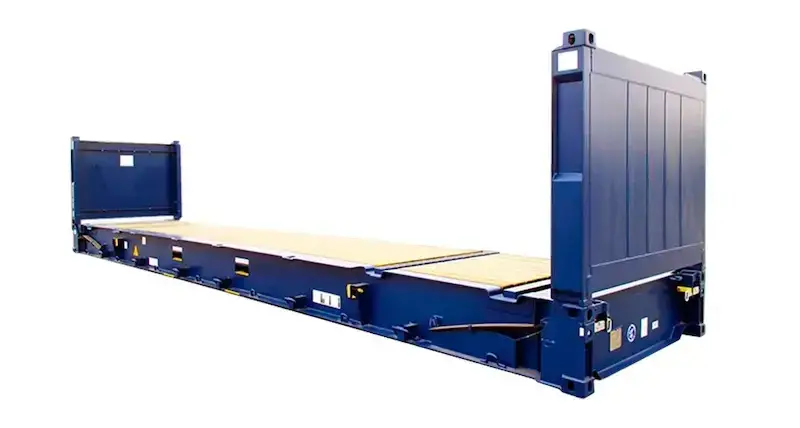
Flat rack containers are designed to transport heavy or cargo that cannot be carried due to the size and nature such as boats of factory parts and equipment.
They have sides and ends that can collapse, which makes for easy loading and unloading from the top or sides. These containers are commonly used for shipping machinery, vehicles, and construction equipment.
Dimensions: The internal sizes of a flat rack container vary depending on the specific design, but they usually have a length of 20 or 40 feet, a width of 7 feet 6 inches, and a height of 7 feet 5 inches.
Read More on How Do Shipping Containers Make Money?
Open-Top Containers
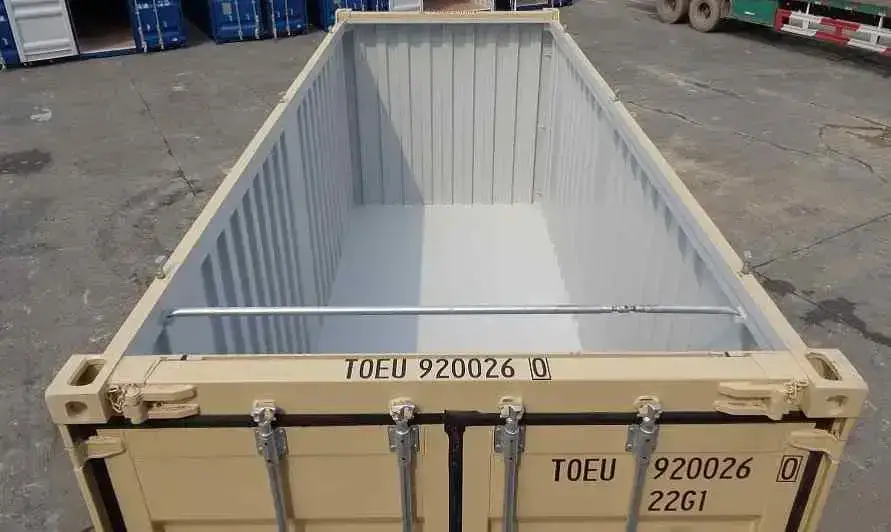
Open-top containers are similar to standard containers, but they do not have a solid roof. Instead, they feature a removable tarpaulin or a hard roof that can be completely or partly removed.
In short, these containers are ideal for cargo that needs to be loaded from the top or requires easier access.
Dimensions: The internal sizes of an open top 20-foot container are roughly 19 feet 4 inches in length, 7 feet 8 inches in width, and 7 feet 10 inches in height.
The internal sizes of an open top 40-foot container are roughly 39 feet 5 inches in length, 7 feet 8 inches in width, and 7 feet 10 inches in height.
Read More on Shipping Container Basement: How To Burry A Container
Refrigerated Containers
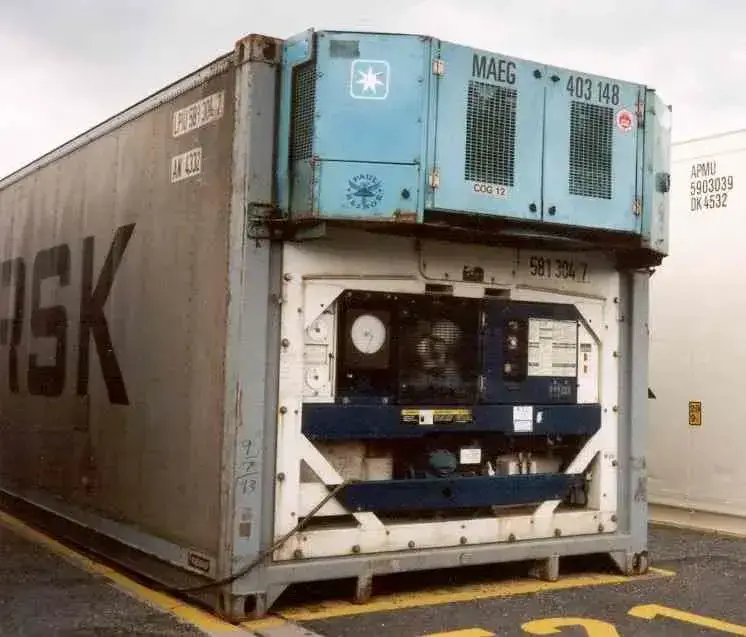
Refrigerated containers, also known as reefers, are made together with a cooling system that maintains a specific temperature range.
They are very important for moving goods that go bad easily, such as food, pharmaceuticals, and chemicals, that require temperature control.
Dimensions: The internal sizes of a refrigerated 20-foot container are roughly 17 feet 11 inches in length, 7 feet 6 inches in width, and 7 feet 6 inches in height.
The internal size of a refrigerated 40-foot container are roughly 37 feet 11 inches in length, 7 feet 6 inches in width, and 7 feet 6 inches in height.
Take time to realize that most of the containers we have shown you look quite old. This is because the shipping companies would hardly sell to you new containers, and in case they do, they would be quite expensive.
And since we are hoping to cut costs, then you can see how a new container would play against this saving that we hope to achieve.
Read More on Container Home Builders in Georgia: Whose The Best?
C. Shipping Container Dimensions and Capacity
As I have shown, containers come in standard sizes, with the most common lengths being 20 feet and 40 feet.
However, there are also containers available in other lengths, such as 45 feet and 53 feet. And so the weight limits and load capacities of containers vary depending on their size and design.
Standard Sizes
- A 20-foot container is roughly 1,170 cubic feet and can hold around 24-28 metric tons of cargo.
- A 40-foot container is roughly 2,390 cubic feet and can hold around 26-30 metric tons of cargo.
- A 45-foot container is roughly 3,040 cubic feet and can hold around 27-32 metric tons of cargo.
- A 53-foot container is roughly 3,570 cubic feet and can hold around 27-32 metric tons of cargo.
Weight limits and load capacities: The weight limits and load capacities of shipping containers depend on various factors, including local regulations and transportation methods. It is important to consult the relevant guidelines and authorities to ensure that you follow the rules.
Read More on Shipping Container Home In Adelaide – Expert Review
Container Construction Materials
Overview of Materials Used in Shipping Container Construction
When it comes to sea container construction, the two main materials used are steel and aluminum. Without a doubt, both materials have their own unique characteristics that make them the number one choice for building durable containers.
Steel
To add, steel is the most commonly used material in sea container construction. It is known for its strength, durability, and resistance to impact and harsh weather conditions. Containers made of steel offer excellent protection for the cargo stored inside.
Aluminum
While not as common as steel, aluminum containers are gaining popularity due to their lighter weight. To point out, aluminum is known for its rust resistance and is well suited for transporting goods that require a lighter load.
However, aluminum containers may not provide the same level of durability as steel ones.
Read More on Container Home Builders In Colorado: Are They Worth It?
Advantages and Disadvantages of Different Materials
Durability
Steel containers are highly durable and can stand against extreme conditions, such as heavy loads, rough handling, and exposure to elements. Aluminum containers, on the other hand, may be more prone to dents and damage.
Weight
Steel containers are heavier compared to aluminum ones. This can make a difference when it comes to transportation costs and limitations. Aluminum containers offer the advantage of being lighter, which allows for more payload capacity.
Insulation Properties
Steel containers have excellent insulation properties, making them a great choice for goods that require consistent temperature control.
Aluminum containers, however, may not provide the same level of insulation and may require extra measures to maintain desired temperature conditions.
Read More on A Closer Look At Wind Power For Homes
Shipping Container Logistics and Transportation
Indeed, transporting sea containers efficiently and safely is crucial for global trade. At this time, let’s take a closer look at the logistics and transportation aspects of containers.
A. Overview of Container Logistics
Container logistics refers to the movement and handling of containers across various modes of transportation, including trains, trucks, and ships.
This intermodal transportation ensures easy and smooth delivery of goods from the point of origin to the final point.
Read More on Container Home Builders In Ohio: 5 Must-Know Expert Builders
B. Integration of Shipping Containers Into Supply Chain Processes
Shipping containers play a pivotal role in supply chain processes. Terminal operations involve the loading and unloading of containers onto ships or trucks, which makes it possible for smooth transfers between different modes of transport.
Coordination and tracking systems are used to monitor container movement and provide real-time updates to stakeholders.
By adding sea containers into supply chain processes, companies can streamline their operations, reduce costs, and improve overall efficiency. These containers provide a standardized method of transport, which makes it easier for planning and coordination.
Read More on Shocking Weight A Container Roof Can Hold
Containerization and its Impact on International Trade
Containerization has revolutionized international trade in numerous ways, leading to significant advancements in global commerce and supply chain management.
A. Advantages of Containerization for Global Trade
- Increased speed, security, and reliability: Prior to containerization, cargo was loaded and unloaded individually, which meant that there was slower and less secure transportation.
With the introduction of shipping containers, goods can now be efficiently moved from ship to train to truck, reducing manual handling and speeding up the entire logistics process.
Furthermore, containers provide enhanced protection against damage and theft, ensuring the safe delivery of goods. - Reduction in cargo handling costs and theft risks: Containerization has significantly reduced the need for manual labor in the handling and moving of goods from ship to shore, or shore to ship.
This has not only led to cost savings but also minimized the chances of theft and loss during transportation. The standardization of container sizes and handling methods has streamlined the entire process, making it more efficient and cost effective.
Read More on Container Pools In Brisbane: Expert Review
B. Case Studies Highlighting the Impact of Containerization
Containerization has had a big impact on the growth of ports and economic development worldwide. Let’s explore a few notable examples:
- Growth of ports and economic development: The adoption of containerization has changed numerous ports into major hubs of commerce and economic activity.
Ports that took advantage of containerization saw a significant increase in trade volume, job creation, and overall economic growth.
The ability to handle large volumes of containerized cargo efficiently has attracted investments, leading to the development of infrastructure and ancillary industries. - Examples from China, the United States, and other countries: China’s rapid economic growth can be linked, in part, to its wide use of containerization.
The country’s ports, such as Shanghai and Shenzhen, have experienced exponential growth and have become vital links in global supply chains.
Similarly, ports in the United States, such as Los Angeles and Long Beach, handle millions of containers each year, driving economic activity in their respective regions.
Other countries, including Singapore, South Korea, and Germany, have also witnessed the transformative impact of containerization on their trade and economic landscapes.
Containerization has undoubtedly revolutionized international trade, offering numerous advantages and fostering economic growth in various regions.
The standardization and efficiency brought about by containers have made global commerce more accessible, reliable, and secure.
Read More on 40 Foot Shipping Container Home Floor Plans
Container Security and Tamper-Proofing Techniques
Ensuring container security is of utmost importance in the world of international trade. With the added threats of cargo theft, smuggling, and terrorism, it is crucial to implement effective security measures to safeguard goods that are on the move.
A. Importance of Container Security in International Trade
The risks associated with inadequate container security are significant. Cargo theft, for instance, can result in massive financial losses for businesses and disrupt the global supply chain.
Smuggling of illegal contraband is another concern, which can have severe legal and economic ramifications. Moreover, the threat of terrorism adds an extra layer of risk to containerized shipments.
Read More on Shipping Container Homes in Oregon: Sustainability And Style
B. Security Measures and Technologies Used to Secure Containers
To enhance container security, several measures and technologies have come into play:
- Tracking systems: Advanced tracking systems fitted with GPS technology allow real time monitoring of container movements. This enables companies to track the status and location of their shipments throughout the journey, reducing the chances of theft or tampering.
- Seals: Tamper-evident seals are commonly used to secure containers. These seals provide visible evidence of any tampering attempts, making it easier to identify and take appropriate actions if a security breach occurs.
- Locks: Strong and robust locks are important for not allowing unauthorized access to containers. High-security barrier locks with unique key combinations or digital locks that require access codes provide an added level of protection.
- Electronic monitoring: Electronic monitoring systems utilize sensors and cameras to detect any suspicious activities around containers. These systems can trigger alarms and alerts in case of unauthorized access or tampering.
By adding these security measures and technologies into the sea container industry, the chances of illicit activities and access that is not authorized can be significantly reduced, ensuring the safety and integrity of goods during movement.
Check out these lock below that works great in protecting your goods in a container. It’s quite simple to use, quick and easy to lock and unlock for your, but of course, difficult for the bad guys to break in.
Read More on Shipping Container Homes in Connecticut: Build Your Dream Home
Repurposing or Converting Shipping Containers
Shipping containers have become more than just means of transportation. In recent years, innovative thinkers have discovered countless uses for repurposed containers in various industries.
From architecture to housing, retail to art installations, the possibilities are endless when it comes to repurposing shipping containers.
Innovative Uses of Shipping Containers Beyond Transportation
Architects and designers have slowly come to accept the versatility of sea containers and added them into their projects.
These metal giants have been turned into amazing homes, offices, hotels, restaurants, and even shopping malls. With a touch of creativity and ingenuity, the humble sea container can become a unique and eye catching structure in any setting.
Artists and artisans have also discovered the appeal of repurposed sea containers. These containers have been used to create pop-up galleries, outdoor theaters, and unconventional exhibition spaces.
The robustness and portability of these containers make them an ideal choice for temporary installations and events.
- Shipping container houses designed with eco friendliness in mind.
- Container hotels offering a unique and unconventional lodging experience.
- Shipping container shops and cafes serving as trendy retail spaces.
- Pop-up bars and restaurants utilizing the mobility of containers for easy relocation.
- Art installations and outdoor exhibitions for showing creativity in unconventional settings.
Note that not everyone thinks that these types of homes are good idea, in fact they say that they are a scam. A scam in the sense that it can be difficult to get permits in some places, you’re limited to the design options since they come in a square shape.
Most potential home owners also have other reasons such as since they are made out of metal, then they are prone to rusting. Also, some believe that since they cost almost the same as a house made out of timber, then why not just build a timber house and avoid the headache of getting yourself a container?
These are all important points, but above all, despite their short falls, these homes also have a lot of advantages that make them a great choice.
Read More on Container Pools Canada: Revolutionizing Swimming Pool Design
Benefits and Challenges of Repurposing Containers
Repurposing or converting containers offers numerous advantages. Sustainability is a key factor, as these containers are often recycled and repurposed, reducing waste and minimizing the need for new construction materials.
Additionally, using sea containers for projects can be a cost effective solution, especially compared to traditional building methods.
Moreover, repurposing containers provides a high level of customization possibilities. The modular nature of containers allows for easy modifications, making it possible to create unique designs made towards specific needs.
However, repurposing containers also comes with challenges. The process may require extra structural reinforcements, insulation, and proper ventilation to ensure the container is suitable for its new purpose.
Adhering to building codes and rules can sometimes pose difficulties, requiring meticulous planning and expertise.
Despite these challenges, the benefits of repurposing sea containers are way bigger than the disadvantages.
Their versatility, affordability, and sustainability make them an attractive choice for those looking for creative and innovative solutions in various industries.
Read More on Shipping Container Homes In Arkansas: Exclusive Review
Shipping Container Terminology and Industry-Specific Jargon
When it comes to shipping containers, there are a variety of terms and jargon that may be unfamiliar to those outside the industry.
To help you understand this complex language, we have compiled a list of key terminology and abbreviations commonly used in the shipping container industry.
A. Glossary of Common Terms Used in the Shipping Container Industry
1. TEU: TEU stands for Twenty-foot Equivalent Unit and is a unit of measurement used to calculate the carrying capacity of a container ship. One TEU is equivalent to a 20-foot container.
2. Reefer: A reefer is a shipping container equipped with refrigeration capabilities, used for transporting perishable goods that require temperature control.
3. Chassis: A chassis is the undercarriage that supports a shipping container when it is being transported by truck or train. It includes the wheels, axles, and connecting mechanism.
4. CSC Plate: The CSC Plate, also known as the Container Safety Convention plate, is a standardized plate that provides essential information about the shipping container, such as its maximum payload, stacking weight, and manufacturing date.
5. Twist Locks: Twist locks are mechanisms used to secure shipping containers together during stacking or transportation. They ensure that containers remain securely attached to each other, preventing potential accidents or cargo damage.
Read More on Container Home Builders In Indiana: Jaw-Dropping Review
B. Understanding Container-Related Abbreviations and Codes
1. ISO: ISO stands for International Organization for Standardization. ISO standards play a crucial role in maintaining consistency and interoperability within the shipping container industry.
2. TARE Weight: TARE weight refers to the weight of an empty shipping container, excluding the weight of its cargo and any packaging materials.
3. HC: HC stands for High Cube. High Cube containers are taller than standard containers, providing additional height and volume for oversized or bulky cargo.
4. SOC: SOC stands for Shipper-Owned Container. SOC refers to a situation where the shipper owns the container being used to transport their goods rather than leasing or renting a container from a shipping line or container provider.
5. IMO: IMO stands for International Maritime Organization and is responsible for setting international regulations and safety standards for the shipping industry. They address areas such as dangerous goods, pollution prevention, and vessel security.
By familiarizing yourself with these shipping container terms and industry-specific jargon, you will gain a better understanding of the logistics and operations involved in the shipping container industry.
Read More on Shipping Container Homes in New Mexico: Expert Look

Conclusion
Shipping containers have revolutionized the logistics and transportation industry, playing a vital role in today’s global economy.
Through the recap of key facts about shipping containers, we have explored their history, evolution, types, dimensions, and construction materials.
We have also delved into container logistics, containerization’s impact on international trade, security measures, repurposing possibilities, and industry-specific terminology.
These steel giants have transformed the way goods are transported across the world, allowing for greater efficiency and cost effectiveness.
Their standardization and modularity have facilitated seamless global trade, enabling businesses to expand and reach international markets with ease.
China and the United States are prime examples of countries that have gained tremendously from containerization. The adoption of shipping containers has moved their economies forward, facilitating the import and export of goods on a massive scale.
In conclusion, shipping containers are the unsung heroes of the global supply chain. Without them, international trade as we know it would not be possible.
Their impact cannot be underestimated, as they continue to shape the way goods are moved, stored, and sent across borders.
Read More: How Much Does A Used Shipping Container Cost? Expert Guide

Friday 24th of March 2023
5